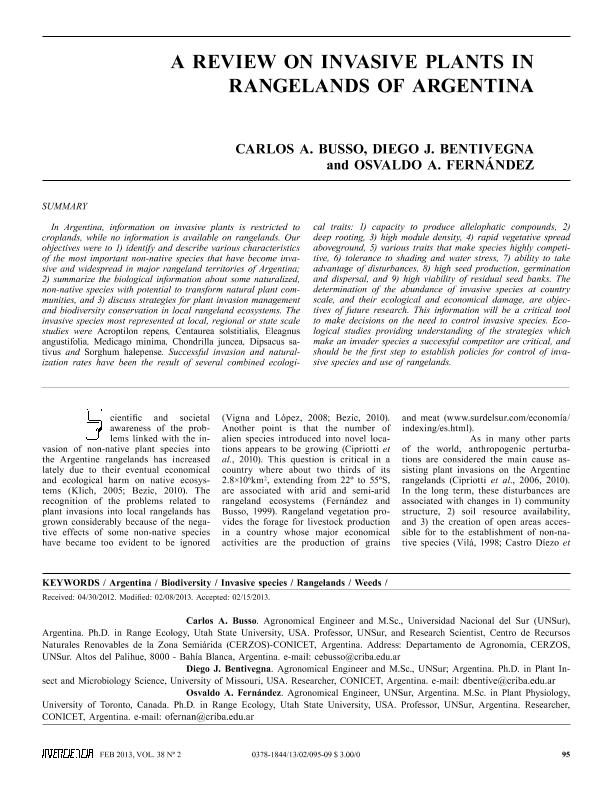Mostrar el registro sencillo del ítem
dc.contributor.author
Busso, Carlos Alberto

dc.contributor.author
Bentivegna, Diego Javier

dc.contributor.author
Fernandez, Osvaldo Alberto

dc.date.available
2017-02-06T18:37:14Z
dc.date.issued
2013-02
dc.identifier.citation
Busso, Carlos Alberto; Bentivegna, Diego Javier; Fernandez, Osvaldo Alberto; A review on invasive plants in rangelands of Argentina; Interciencia; Interciencia; 38; 2; 2-2013; 95-103
dc.identifier.issn
0378-1844
dc.identifier.uri
http://hdl.handle.net/11336/12543
dc.description.abstract
In Argentina, information on invasive plants is restricted to croplands, while no information is available on rangelands. Our objectives were to 1) identify and describe various characteristics of the most important non-native species that have become invasive and widespread in major rangeland territories of Argentina; 2) summarize the biological information about some naturalized, non-native species with potential to transform natural plant communities, and 3) discuss strategies for plant invasion management and biodiversity conservation in local rangeland ecosystems. The invasive species most represented at local, regional or state scale studies were Acroptilon repens, Centaurea solstitialis, Eleagnus angustifolia, Medicago minima, Chondrilla juncea, Dipsacus sativus and Sorghum halepense. Successful invasion and naturalization rates have been the result of several combined ecological traits: 1) capacity to produce allelophatic compounds, 2) deep rooting, 3) high module density, 4) rapid vegetative spread aboveground, 5) various traits that make species highly competitive, 6) tolerance to shading and water stress, 7) ability to take advantage of disturbances, 8) high seed production, germination and dispersal, and 9) high viability of residual seed banks. The determination of the abundance of invasive species at country scale, and their ecological and economical damage, are objectives of future research. This information will be a critical tool to make decisions on the need to control invasive species. Ecological studies providing understanding of the strategies which make an invader species a successful competitor are critical, and should be the first step to establish policies for control of invasive species and use of rangelands.
dc.format
application/pdf
dc.language.iso
eng
dc.publisher
Interciencia

dc.rights
info:eu-repo/semantics/openAccess
dc.rights.uri
https://creativecommons.org/licenses/by-nc-sa/2.5/ar/
dc.subject
Invasive Plants
dc.subject
Argentina
dc.subject
Rangelands
dc.subject.classification
Ecología

dc.subject.classification
Ciencias Biológicas

dc.subject.classification
CIENCIAS NATURALES Y EXACTAS

dc.title
A review on invasive plants in rangelands of Argentina
dc.type
info:eu-repo/semantics/article
dc.type
info:ar-repo/semantics/artículo
dc.type
info:eu-repo/semantics/publishedVersion
dc.date.updated
2016-12-01T19:40:27Z
dc.journal.volume
38
dc.journal.number
2
dc.journal.pagination
95-103
dc.journal.pais
Venezuela

dc.journal.ciudad
Caracas
dc.description.fil
Fil: Busso, Carlos Alberto. Universidad Nacional del Sur. Departamento de Agronomía; Argentina. State University Of Utah; Estados Unidos. Consejo Nacional de Investigaciones Científicas y Técnicas. Centro Científico Tecnológico Bahía Blanca. Centro de Recursos Naturales Renovables de la Zona Semiárida(i); Argentina
dc.description.fil
Fil: Bentivegna, Diego Javier. Universidad Nacional del Sur; Argentina. University Of Missouri; Estados Unidos. Consejo Nacional de Investigaciones Científicas y Técnicas; Argentina
dc.description.fil
Fil: Fernandez, Osvaldo Alberto. Universidad Nacional del Sur; Argentina. State University Of Utah; Estados Unidos. Consejo Nacional de Investigaciones Científicas y Técnicas; Argentina
dc.journal.title
Interciencia

dc.relation.alternativeid
info:eu-repo/semantics/altIdentifier/url/http://www.redalyc.org/articulo.oa?id=33926950007
Archivos asociados
